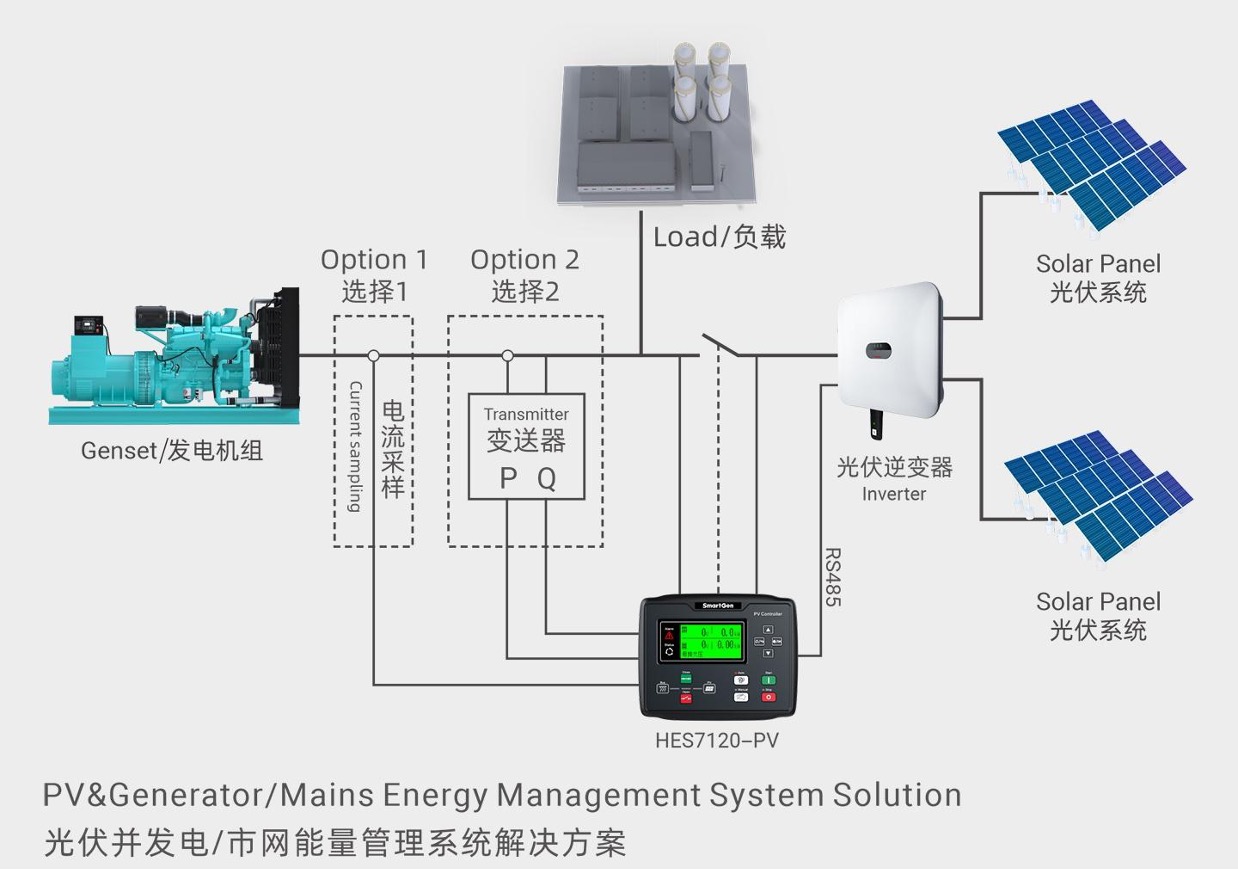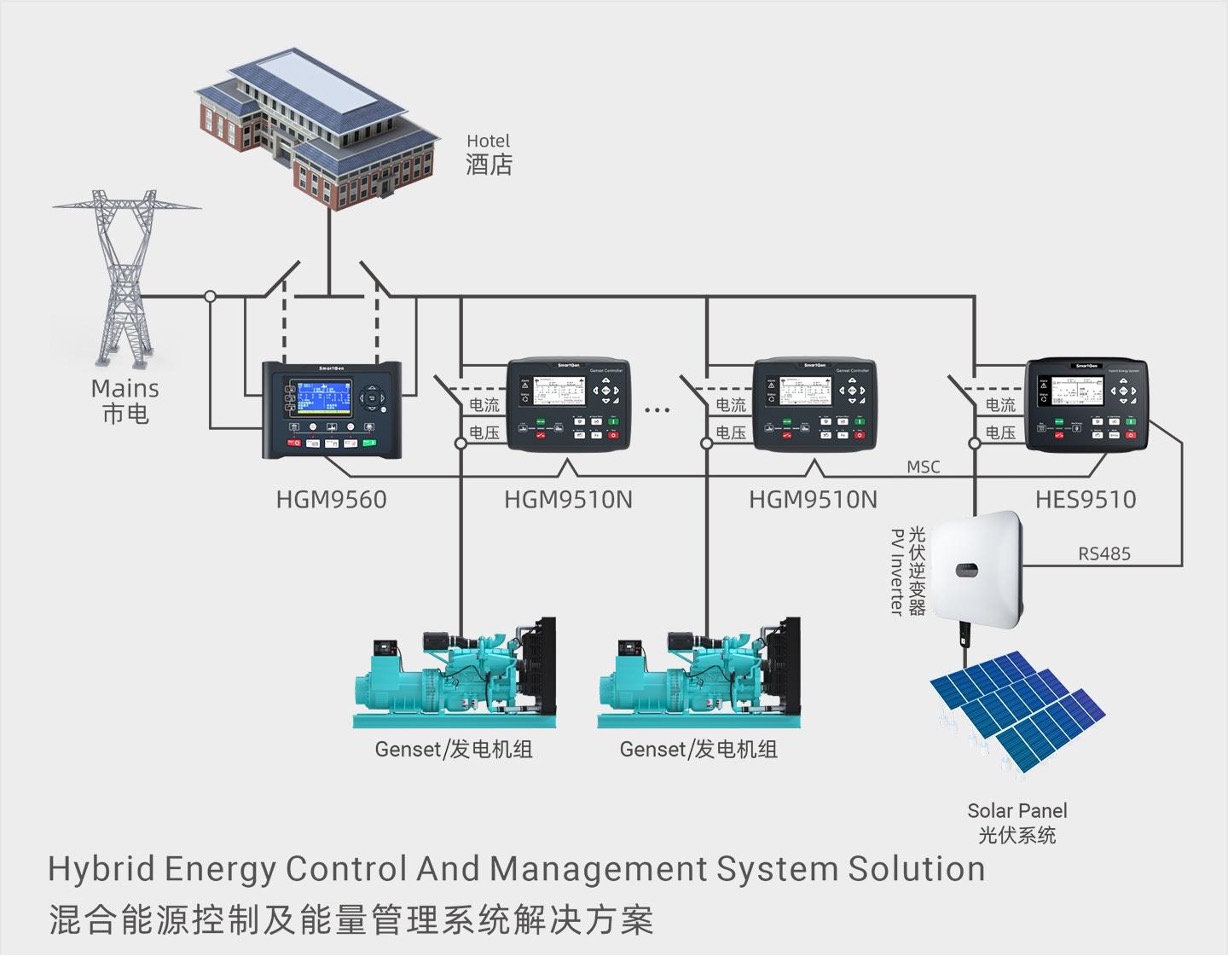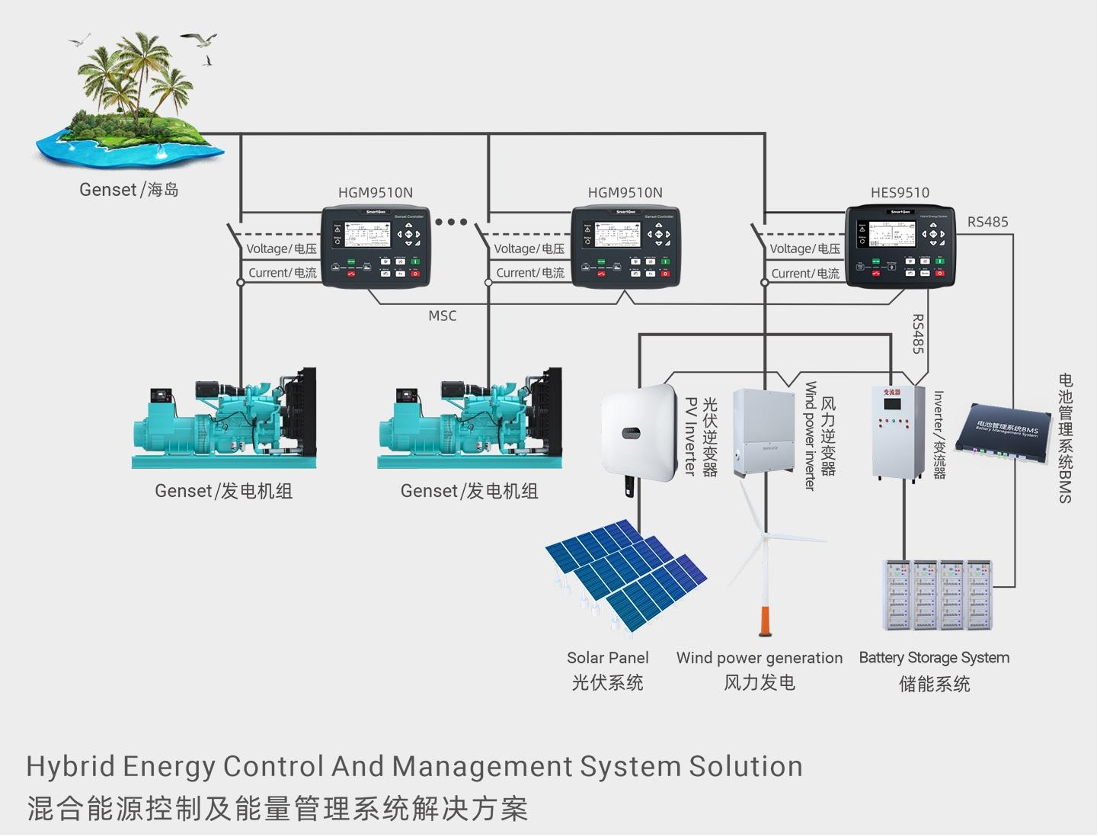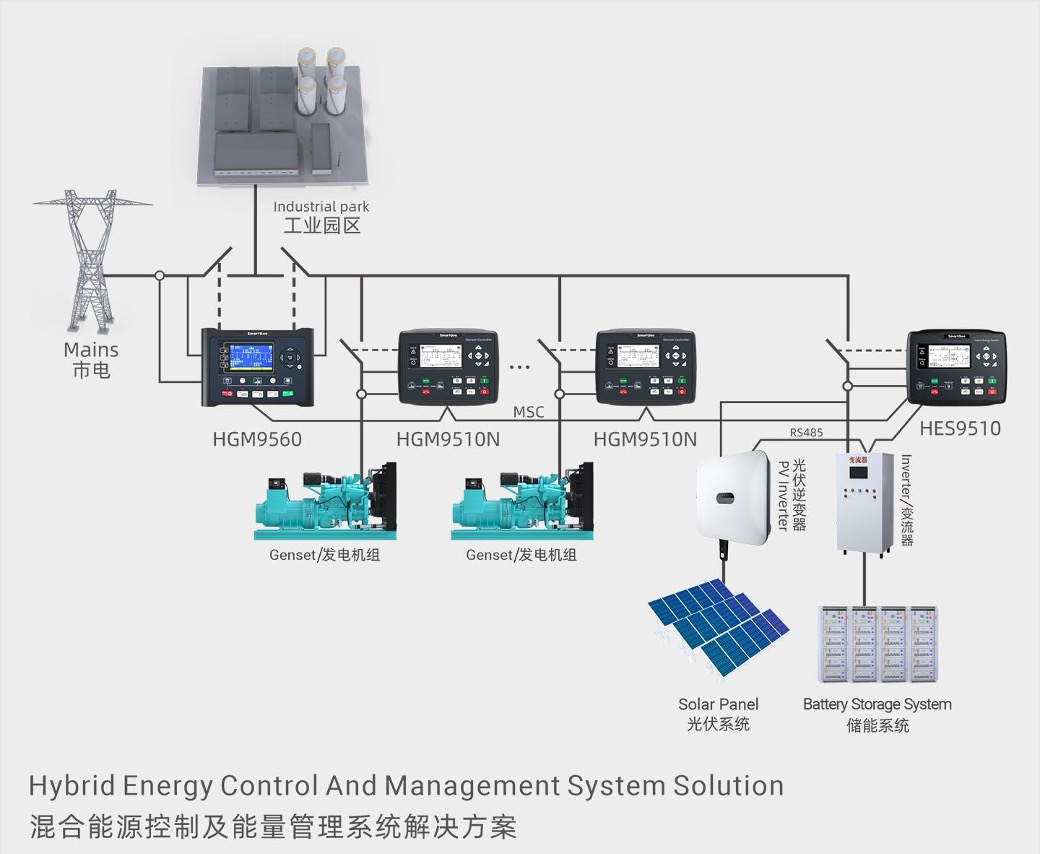Diesel Generator & Solar-Storage Hybrid Power Solution
PT Cumsen Power Indonesia Provides Efficient and Sustainable Energy Solutions
With the increasing demand for energy and stricter environmental regulations, the combination of diesel generator sets with solar power and energy storage has become a reliable, efficient, and sustainable energy solution. PT Cumsen Power Indonesia, leveraging its extensive experience in diesel generator sets, energy storage, and microgrid integration, offers tailored hybrid power solutions to help clients reduce operational costs and transition toward greener energy sources.
Diesel Generators + Solar Power + Energy Storage: A Highly Efficient Energy Mix
Diesel generators provide stable and reliable power, while solar systems deliver clean, renewable energy. Energy storage solutions balance load fluctuations and optimize energy usage. By integrating these three components, we can significantly reduce diesel consumption, lower carbon emissions, and improve overall energy efficiency.
Our Solution Advantages
✅ Advanced Diesel Generator Technology
PT Cumsen Power Indonesia has extensive experience in supplying diesel generator sets from world-renowned brands such as Cummins, Yuchai, and Isuzu. With a wide power range and adaptability to various conditions, our generator sets are designed to be highly efficient, durable, and customizable to meet specific client needs.
✅ Integrated Solar Power and Energy Storage Systems
In addition to diesel generator sets, we provide integrated solar power systems and high-efficiency battery storage solutions. Our smart energy management system maximizes the utilization of renewable energy by prioritizing solar power during the day while storing excess electricity. At night or when sunlight is insufficient, the stored energy or diesel generators supply power, ensuring optimal energy efficiency.
✅ Reduced Operational Costs and Optimized Energy Consumption
Traditional diesel generators require high fuel and maintenance costs. By incorporating solar and storage solutions into a hybrid system, we help clients significantly reduce diesel consumption, lower maintenance expenses, and minimize greenhouse gas emissions, achieving both environmental and economic benefits.
✅ Ideal for Remote and Off-Grid Locations
For areas without stable grid connections, such as remote villages, mining sites, islands, and construction sites, diesel generators remain a primary power source. However, by integrating solar and storage solutions, we reduce dependency on diesel, lower fuel transportation costs, and enhance energy security and sustainability.
✅ Comprehensive Lifecycle Support
From system design, equipment supply, installation, and commissioning to long-term maintenance, PT Cumsen Power Indonesia provides end-to-end services. We not only deliver high-quality equipment but also offer remote monitoring and smart operation and maintenance services to ensure optimal system performance.
Application Scenarios
Off-Grid Power Stations – Ideal for islands, remote villages, and mountainous areas without grid coverage
Mining and Construction Sites – Provides reliable power supply while reducing fuel transportation costs
Industrial Parks – Optimizes energy consumption, lowers carbon emissions, and improves cost efficiency
Commercial & Residential Microgrids – Enables smart energy management and cost-effective power solutions
Conclusion
As a leading power solutions provider in Indonesia, PT Cumsen Power Indonesia is committed to delivering efficient and sustainable energy systems. Our diesel generator and solar-storage hybrid power solution helps clients reduce operational costs, increase energy independence, and promote the adoption of clean energy.
If you are looking for a reliable and cost-effective power solution, contact us today to build a greener and more efficient energy future together!

- System Components
The system consists of the following key components:
- Solar Power System (Solar Panel): Provides clean, renewable energy, reducing the operating hours of diesel generators, lowering carbon emissions and fuel costs.
- Diesel Generator Set (Genset): Serves as a backup and supplementary power source, ensuring stable electricity supply when solar generation is insufficient.
- Inverter: Converts DC power generated by the solar panels into AC power for load consumption.
- Load: Represents the electrical demand, including factories, data centers, mines, and power stations.
- Energy Management Controller (HES7120-PV): Intelligently manages the power output of the diesel generator and solar power system for optimal coordination.
- Transmitter (PQ) (Option 2) or Current Sampling (Option 1): Monitors the load demand in real-time to optimize energy distribution.
- Working Principle
The core concept of this energy management system is to achieve coordinated power generation between solar PV and diesel generators, maximizing renewable energy utilization while ensuring a stable power supply to the load. The main operating mechanisms are as follows:
Intelligent Load Distribution
The load demand is monitored in real-time by the energy management controller, dynamically adjusting the solar PV output based on changes in load.
When the load demand is low, the solar PV system is prioritized, and the generator’s output is minimized or even put into standby mode, thereby reducing fuel consumption.
Minimum Load Power Protection
Diesel generators require a minimum load threshold (typically 30%-50% of rated capacity). Running at a low load for extended periods can lead to carbon buildup, fuel wastage, and unstable operation.
The system adjusts the solar power output to ensure the generator operates at or above the minimum load threshold, preventing mechanical damage due to low-load operation.
Maximizing Solar Output
When solar generation is sufficient (such as on sunny days), the system prioritizes solar power usage, reducing the generator’s output.
However, if the load demand increases or solar power is insufficient (such as at night or during cloudy weather), the system automatically increases generator output to maintain stable power supply.
Seamless Switching Between Grid-Tied and Off-Grid Modes
- The system is adaptable to different applications, supporting both off-grid (standalone) operation and grid-tied operation.
- In grid-tied mode, excess solar power can be fed back to the grid or stored for later use.
- In off-grid mode, the diesel generator and solar PV system work together to ensure continuous power supply, particularly in remote locations such as islands, mining sites, and rural villages.
- System Advantages
✅ Reduced Fuel Consumption: Solar PV reduces the generator’s operating hours, cutting fuel costs.
✅ Lower Carbon Emissions: Promotes clean energy use and aligns with sustainability goals.
✅ Intelligent Management: Automatically adjusts power output between solar and generators, optimizing energy efficiency.
✅ Extended Equipment Lifespan: Prevents generators from prolonged low-load operation, reducing wear and tear.
✅ High Adaptability: Suitable for various applications, including industrial sites, remote areas, and microgrids.

- System Components
The system consists of the following key components:
- Mains (Grid Power): The primary electricity source supplying power to the connected load, such as a hotel, industrial facility, or commercial building.
- Solar Power System (PV Panels): Generates renewable energy, reducing dependence on grid electricity and lowering operational costs.
- Diesel Generator Sets (Gensets): Serve as backup power sources, ensuring continuous power supply when grid electricity is unavailable or restricted.
- Hybrid Control Units (HGM9560, HGM9510N, HGM9510, HES9510): These controllers manage the interaction between different power sources, automatically switching and optimizing the power supply based on system conditions.
- Inverter (PV Inverter): Converts solar power from DC to AC for grid integration and load consumption.
- Load (Hotel or Other Facility): Represents the energy consumption points, which require stable and efficient electricity supply.
- Normal Operation Mode (Grid-Tied PV Priority)
In a normal scenario where the mains power is available and stable, the system prioritizes the use of solar PV energy.
The solar power system is grid-connected and generates electricity to supply the load.
This reduces reliance on the grid, effectively lowering electricity costs, especially in areas with high tariffs or step-pricing mechanisms.
Diesel generator sets remain on standby and are not activated unless required, minimizing fuel consumption and reducing emissions.
- Abnormal Operation Mode (Backup and Hybrid Power Switching)
If the system detects abnormal grid conditions, such as mains power failure, power limitations, or high electricity tariffs, the system automatically adjusts the power sources:
PV and gensets switch to direct load supply to ensure continuous power.
If the grid experiences a complete failure, the system automatically starts the diesel generators to compensate for the lost power.
The hybrid controller ensures smooth transitions between power sources, preventing any interruptions in electricity supply.

- System Components
The hybrid system consists of the following key components:
- Wind Power System (Wind Turbine + Wind Power Inverter): Generates renewable energy, particularly effective in windy environments, and contributes to charging the battery storage system.
- Solar Power System (PV Panels + PV Inverter): Provides clean energy during the daytime, reducing reliance on diesel generators.
- Battery Storage System (BMS + Battery Pack): Stores excess energy generated by wind and solar power during the day and supplies power at night or during low-energy periods.
- Diesel Generator Sets (Gensets): Act as a backup power source, ensuring continuous electricity supply when battery storage is insufficient.
- Hybrid Controllers (HGM9510N, HES9510, MSC): Manage power generation, load distribution, and system switching between different energy sources.
- Load (Island or Off-Grid Facility): Represents the power consumption area, ensuring stable electricity for businesses, hotels, or industrial operations in isolated locations.
- Normal Operation Mode (Renewable Energy Priority)
During normal operation, the system prioritizes renewable energy sources:
During the daytime, solar power and wind energy charge the battery storage system while simultaneously supplying electricity to the load.
At night, wind power and the battery storage system take over the energy supply, ensuring uninterrupted power without relying on the diesel generators.
Diesel generators remain on standby and are only activated when battery levels drop below a critical threshold.
- Backup Operation Mode (Diesel Generator Support)
When the system detects low battery levels or insufficient wind and solar power, the diesel generators automatically start and take over the load:
This ensures continuous power supply, preventing disruptions due to energy shortages.
The hybrid controller intelligently manages the generator runtime, ensuring it operates efficiently and only when necessary, reducing fuel consumption and maintenance costs.

- System Components
The hybrid system consists of the following key components:
- Mains (Grid Power): Serves as the primary power source for the industrial park.
- Diesel Generator Sets (Gensets): Provide backup and supplementary power during grid restrictions or outages.
- Solar Power System (PV Panels + PV Inverter): Generates renewable energy, reducing electricity costs and dependency on the grid.
- Battery Storage System (BMS + Battery Pack): Stores excess energy for later use, helping to manage peak demand and optimize energy costs.
- Hybrid Controllers (HGM9560, HGM9510N, HES9510, MSC): Manage and coordinate power distribution among the different energy sources, ensuring seamless transitions and system stability.
- Industrial Load: Represents the power consumption of the industrial park, ensuring continuous electricity supply for production operations.
- Normal Operation Mode (Grid-Tied with Renewable Energy Priority)
Under normal conditions, the system operates in an optimized grid-tied mode with the following energy prioritization:
Solar power is utilized first to supply energy to the industrial park, reducing electricity costs.
Battery storage is charged during periods of excess renewable generation or during off-peak electricity hours.
Diesel generators remain on standby, only activating when required.
- Power Restriction & Peak-Valley Pricing Response Mode
In scenarios where grid power is restricted, expensive, or unavailable, the system dynamically adjusts power sources:
If the grid enforces power limitations, the system activates battery storage to cover the shortfall.
During peak electricity pricing hours, the system prioritizes solar power and battery storage, reducing reliance on expensive grid electricity.
If battery power is insufficient, diesel generators will start automatically to maintain an uninterrupted power supply.

